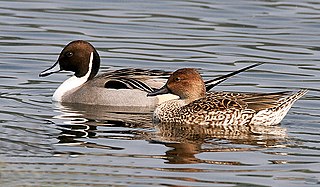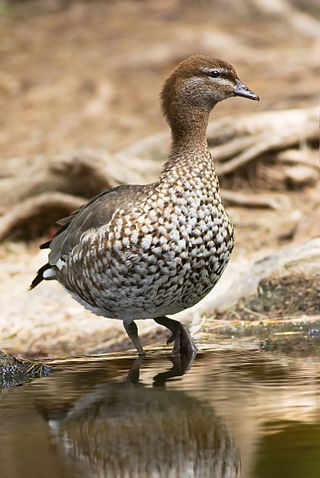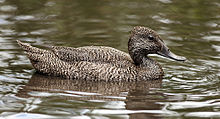
The pintail or northern pintail is a duck species with wide geographic distribution that breeds in the northern areas of Europe and across the Palearctic and North America. It is migratory and winters south of its breeding range to the equator. Unusually for a bird with such a large range, it has no geographical subspecies if the possibly conspecific duck Eaton's pintail is considered to be a separate species.

The gadwall is a common and widespread dabbling duck in the family Anatidae.

The mallard or wild duck is a dabbling duck that breeds throughout the temperate and subtropical Americas, Eurasia, and North Africa. It has been introduced to New Zealand, Australia, Peru, Brazil, Uruguay, Argentina, Chile, Colombia, the Falkland Islands, and South Africa. This duck belongs to the subfamily Anatinae of the waterfowl family Anatidae. Males have green heads, while the females have mainly brown-speckled plumage. Both sexes have an area of white-bordered black or iridescent purple or blue feathers called a speculum on their wings; males especially tend to have blue speculum feathers. The mallard is 50–65 cm (20–26 in) long, of which the body makes up around two-thirds the length. The wingspan is 81–98 cm (32–39 in) and the bill is 4.4 to 6.1 cm long. It is often slightly heavier than most other dabbling ducks, weighing 0.7–1.6 kg (1.5–3.5 lb). Mallards live in wetlands, eat water plants and small animals, and are social animals preferring to congregate in groups or flocks of varying sizes.

The redhead is a medium-sized diving duck. The scientific name is derived from Greek aithuia, an unidentified seabird mentioned by authors including Hesychius and Aristotle, and Latin americana, of America. The redhead is 37 cm (15 in) long with an 84 cm (33 in) wingspan. Redhead weight ranges from 2.0 to 2.5 lbs, with males weighing an average of 2.4 lbs and females weighing an average of 2.1 lbs. It belongs to the genus Aythya, together with 11 other described species. The redhead and the common pochard form a sister group which together is sister to the canvasback.

The common pochard, known simply as pochard in the United Kingdom, is a medium-sized diving duck in the family Anatidae. It is widespread across the Palearctic. It breeds primarily in the steppe regions of Scandinavia and Siberia, and winters further south and west.

The wood duck or Carolina duck is a species of perching duck found in North America. The drake wood duck is one of the most colorful North American waterfowls.

The mandarin duck is a perching duck species native to the East Palearctic. It is sexually dimorphic, males showing a dramatic difference from the females. It is medium-sized, at 41–49 cm (16–19 in) long with a 65–75 cm (26–30 in) wingspan. It is closely related to the North American wood duck, the only other member of the genus Aix. 'Aix' is an Ancient Greek word which was used by Aristotle to refer to an unknown diving bird, and 'galericulata' is the Latin for a wig, derived from galerum, a cap or bonnet. Outside of its native range, the mandarin duck has a large introduced population in the British Isles and Western Europe, with additional smaller introductions in North America.

The musk duck is a highly aquatic, stiff-tailed duck native to southern Australia. It is the only living member of the genus Biziura. An extinct relative, the New Zealand musk duck or de Lautour's duck, once occurred on New Zealand, but is only known from prehistoric subfossil bones. It was about 8% longer than the living species, with a particularly large head.

The hooded merganser is a species of fish-eating duck in the subfamily Anatinae. It is the only extant species in the genus Lophodytes. The genus name derives from the Greek language: lophos meaning 'crest', and dutes meaning 'diver'. The bird is striking in appearance; both sexes have crests that they can raise or lower, and the breeding plumage of the male is handsomely patterned and coloured. The hooded merganser has a sawbill but is not classified as a typical merganser.

The Australian shelduck, also known as the chestnut-breasted shelduck or mountain duck, is a shelduck, a group of large goose-like ducks part of the bird family Anatidae. The genus name Tadorna comes from Celtic roots and means "pied waterfowl". They have a striking chestnut-coloured breast and black body. They are protected under the National Parks and Wildlife Act 1974.

The ferruginous duck, also known as ferruginous pochard, common white-eye or white-eyed pochard, is a medium-sized diving duck from Eurosiberia. The scientific name is derived from Greek aithuia an unidentified seabird mentioned by authors including Hesychius and Aristotle, and nyrok, the Russian name for a duck.

The magpie goose is the sole living representative species of the family Anseranatidae. This common waterbird is found in northern Australia and southern New Guinea. As the species is prone to wandering, especially when not breeding, it is sometimes recorded outside its core range. The species was once also widespread in southern Australia but disappeared from there largely due to the drainage of the wetlands where the birds once bred. Due to their importance to Aboriginal people as a seasonal food source, as subjects of recreational hunting, and as a tourist attraction, their expansive and stable presence in northern Australia has been "ensured [by] protective management".

The grey teal is a dabbling duck found in open wetlands in Australia and New Zealand.

The falcated duck or falcated teal is a gadwall-sized dabbling duck from the east Palearctic.

The Australian wood duck, maned duck or maned goose is a dabbling duck found throughout much of Australia. It is the only living species in the genus Chenonetta. Traditionally placed in the subfamily Anatinae, it might belong to the subfamily Tadorninae (shelducks); the ringed teal may be its closest living relative.

The spotted whistling duck is a member of the duck family Anatidae. It is also referred to as the "spotted tree duck". This duck can be found in Indonesia, New Guinea, Australia and the Philippines. Spotted ducks are also held in captive populations.

The Madagascar pochard or Madagascan pochard is an extremely rare diving duck of the genus Aythya. Thought to be extinct in the late 1990s, specimens of the species were rediscovered at Lake Matsaborimena near Bemanevika in Madagascar in 2006. By 2017, a captive breeding program had produced a population of around 90 individuals. The birds were reintroduced to the wild in December 2018.

The blue-billed duck is a small Australian stiff-tailed duck, with both the male and female growing to a length of 40 cm (16 in). The male has a slate-blue bill which changes to bright-blue during the breeding season, hence the duck's common name. The male has deep chestnut plumage during breeding season, reverting to a dark grey. The female retains black plumage with brown tips all year round. The duck is endemic to Australia's temperate regions, inhabiting natural inland wetlands and also artificial wetlands, such as sewage ponds, in large numbers. It can be difficult to observe due to its cryptic nature during its breeding season through autumn and winter. The male duck exhibits a complex mating ritual. The blue-billed duck is omnivorous, with a preference for small aquatic invertebrates. BirdLife International has classified this species as Least concern. Major threats include drainage of deep permanent wetlands, or their degradation as a result of introduced fish, peripheral cattle grazing, salinization, and lowering of ground water.

Waterfowl hunting is the practice of hunting aquatic birds such as ducks, geese and other waterfowls or shorebirds for food and sport.

Lake Pinaroo lies in the north west corner of Sturt National Park, a protected national park in the Far West region of New South Wales, Australia. The location covers an area of 718.8 ha, approximately 80km north-west of Tibooburra and 24km south-east of Cameron Corner. Grid coordinates 29°06’S, 141°13’E. On 19 March 1996 the lake was recognised as a wetland of international importance by designation (RS799) under the Ramsar Convention.




























